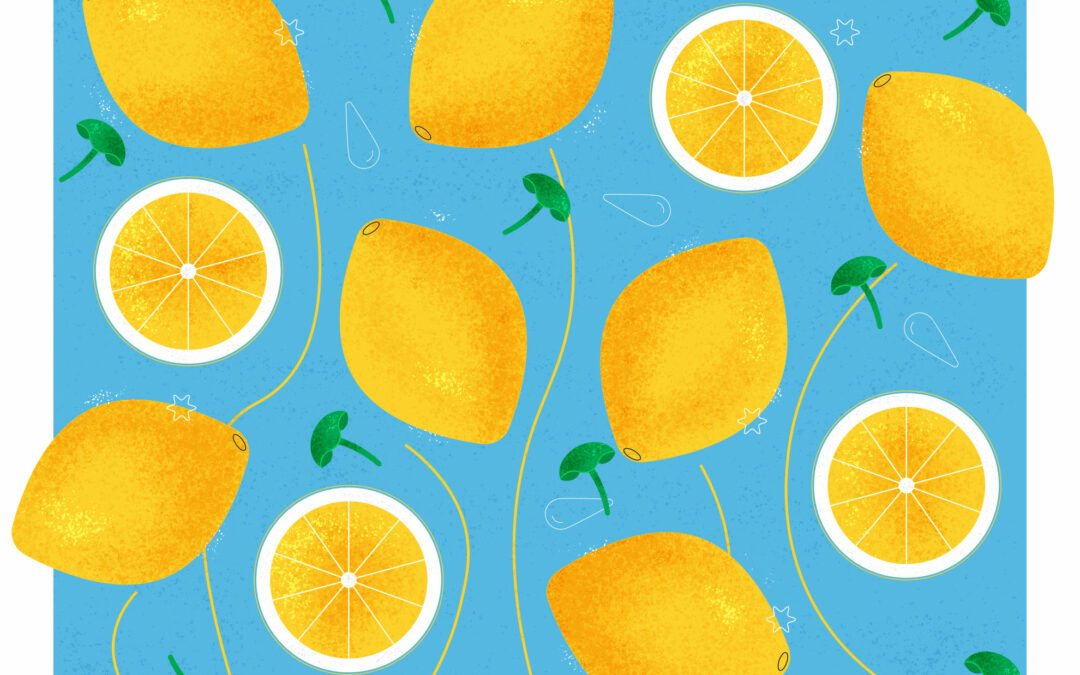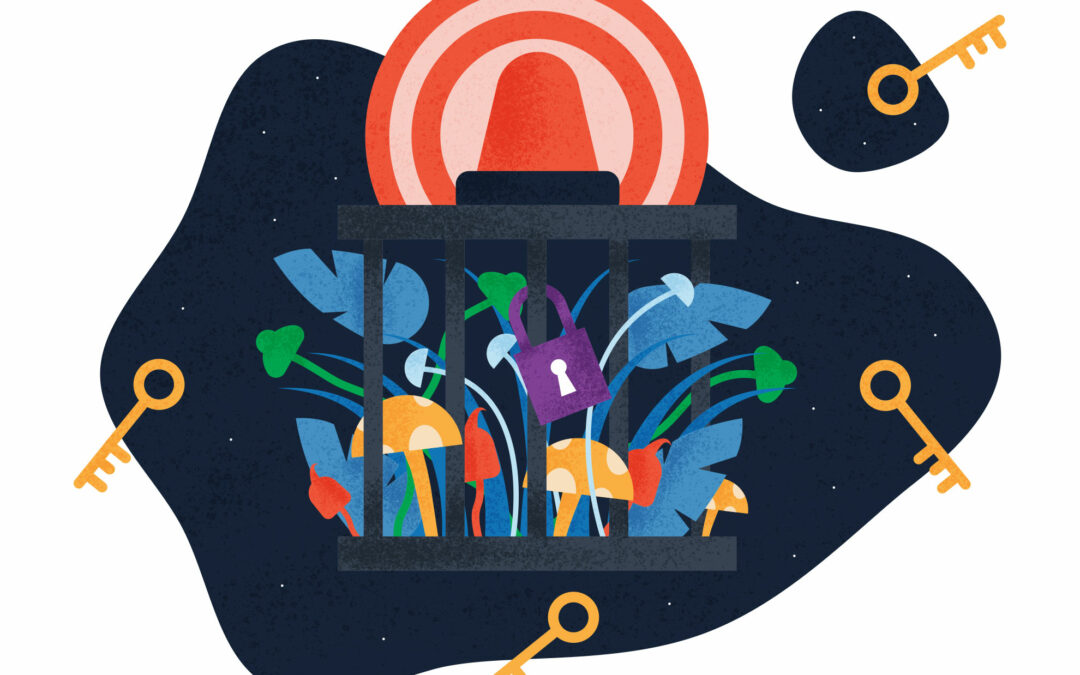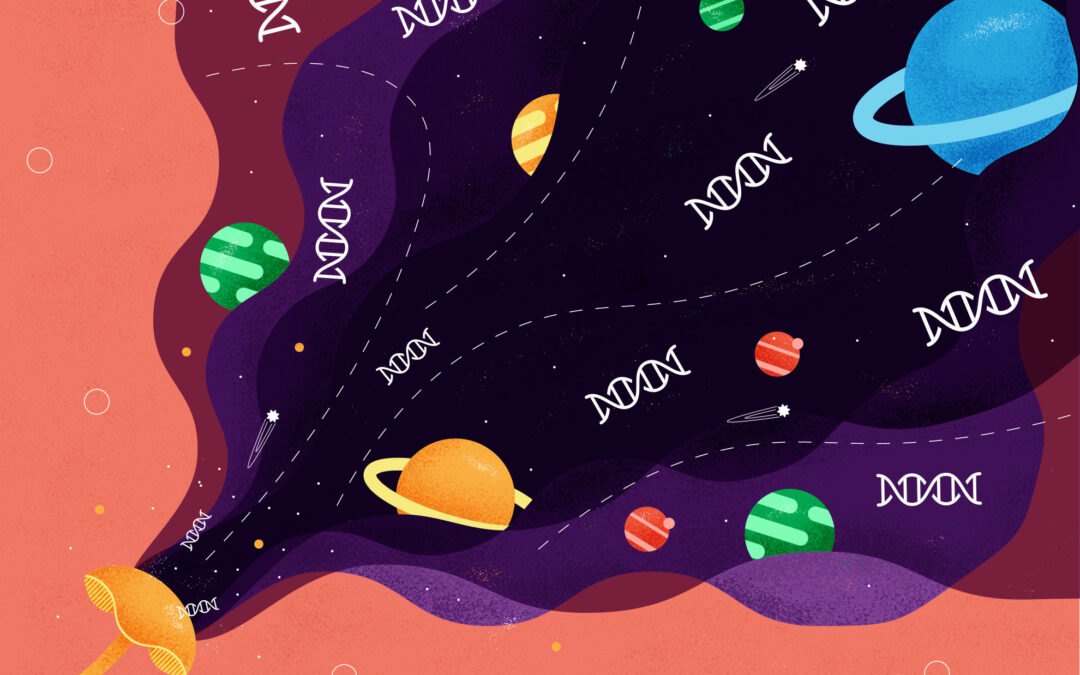
Prochazkova et al. (2018) begins to address the outcomes of microdosing psilocybin-containing fungi. In “Exploring the effect of microdosing psychedelics on creativity in an open-label natural setting,” the study authors explore claims of creativity and problem-solving performance quantitatively in relation to cognition.
“Magic mushrooms,” those of the Psilocybe genus, target the serotonergic system, associated with feelings of well-being and happiness. A “microdose” is generally considered to be between 1/10 (10%) and 1/16 (~6%) of a recreational dose. In 2004, a double-blind placebo-controlled study by Hasler et al. showed that even very low doses of psilocybin (45 µg/kg body weight) were rated clearly psychoactive by most of the volunteers.
The concept was initially introduced to the mainstream through reports on microdosing LSD in Silicon Valley in the early 2010’s, primarily touted for its creativity-boosting powers. Anecdotally, mushrooms have been known for decades to be “beneficial in situations where there is need for mental flexibility, or where one needs to break through rigid patterns of thought.” Small studies have suggested that “microdosing improves the interplay between persistence and flexibility” of thought.”
However, “creativity is a multilayered phenomenon, commonly defined as the ability to generate ideas, solutions, or products that are both novel and appropriate.” It is “not a unitary function but consists of a number of subcomponents.” It combines “convergent thinking, which requires identification of a single solution to a well-defined problem, and divergent thinking, which requires the collection of many possible solutions to a loosely defined problem.”
Previous studies and research have resulted in dissociations of convergent and divergent thinking that might suggest that convergent thinking is impaired by microdosing. However, microdosing has been shown to improve the interplay between persistence and flexibility of thought. Ultimately, the researchers “did not have specific expectations regarding intelligence.”
Study Design
This study makes use of “magic truffles” or sclerotia of certain psilocybin species, legal in the Netherlands. They contain the same psychoactive substances found in “magic mushrooms” and neatly fit into a loophole in local law. For the purpose of this observation, they were completely dried and weighed. Observations were made at a Psychedelic Society of the Netherlands (PSN) event specifically convened to observe the outcomes of microdosing.
They ultimately sought to understand the “cognitive enhancing effects of microdosing on human cognition in a natural setting.” They assessed convergent and divergent thinking separately, by using the Picture Concept Task (PCT; Hurks et al. 2010; Wechsler 2003) and Guilford’s (1967) Alternate Uses Task (AUT), respectively.
Picture Concept Task
The PCT uses images to prompt responses from subjects who are graded on their ability to find connections between concepts. Below is an example graphic from the PCT test of convergent thinking. The subject must conceive of a concept that links an item from each row. A possible solution to this example would be “water”, implicating the tub (3), sink (5) and hose (7).

Alternate Uses Task
Guilford’s AUT assesses divergent thinking in the subjects. It simply requires finding as many uses for a common household item as possible. A common example would be a brick; some options would include “paperweight”, “doorstop”, “weapon”, “a mock altar at a Barbie wedding”, “to break a window”, etc. No specific time limit is suggested, however consistent timing allows for direct comparison.
The responses from the AUT are assessed on four separate criteria:
- Originality: The responses given by each subject are compared to the responses given by all subjects in the study. Unique or “rare” (<5% of subjects) responses are given higher scores.
- Fluency: Simply the total number of responses given by a subject. The score for the brick example above would be 5.
- Flexibility: The number of discrete categories. “Paperweight” and “doorstop” in the example above might both be considered a similar concept or category.
- Elaboration: The depth of detail. “Weapon” may receive 0 or 1 points, whereas “mock altar at a Barbie wedding” might achieve the maximum 2 points.
Execution and Methods
The experiment comprised a baseline assessment before any consumption of psychedelics; a second assessment was undertaken roughly 1.5 hours after the subjects had consumed the substance.
The PSN “did not adhere to any strict guidelines regarding the dosage given to attendees” and “attendees did not have to adhere to the PSN member’s recommendation and were free to choose a dose”. However, suggestions of dosage were made to subjects following body weight. Attendees judged to have a low body weight were recommended to take 0.22 grams of truffles, those with an average body weight 0.33 grams, and those with a high body weight were recommended 0.44 grams of dried truffles.
Study Subjects
38 volunteers were included in this assessment, with the requirements being that they are healthy and spoke the required languages for performing the experimental tasks. Further, they were assessed as to whether they had prior experience with the use of psychedelic substances.
Unfortunately, 13 participants were excluded from at least one test in the trial: Eleven participants had to be excluded from further analysis in the PCT, either due to incorrect interpretation of the task instructions or because they did not complete the task either for the first or second session
Two participants had to be excluded from the AUT as the experimenters were unable to read the individuals’ writing, two more due to missing data on the second session, and one due to misinterpretation of the task instructions. However, individuals that were excluded for the AUT and PCT analysis did not overlap. Data was analysed separately for each task.
Study Substance (Truffles)
‘Truffles’ contain the same active compounds as ‘shrooms or Psilocybe mushrooms, namely Psilocybin, Psilocin, Baeocystin and Norbaeocystin. In the three batches of truffles used and assessed in this trial, the level of the alkaloids was almost identical in all three samples. Quantitative analysis showed the presence of all four investigated alkaloids with predominant levels of psilocybin.
| Alkaloid | ug/g (ppm) | SD | Relative SD |
|---|---|---|---|
| Psilocybin | 1595 | 3.75 | 2% |
| Psilocin | 85 | 0.86 | 10% |
| Norbaeocystin | 8 | 0.06 | 7% |
| Baeocystin | 31 | 0.16 | 5% |
Weaknesses of the Study
Science is best approached with a critical mind, positive results must be weighed against the limitations of the given study. The primary and largest weakness of this research is the lack of a control group, or those who did not ingest the substance under study; all those tested had consumed psychoactive truffles before undergoing the second phase of testing.
In this context, it is “possible that increased performance from the first to the second time point of measurement reflects learning” of the nuances of the test. Practice and experience, regardless of substances consumed, may explain most of the positive improvement observed in the trial. This is further complicated by the AUT having problems of internal contamination, with originality and fluency measures acting multiplicatively in analysis.
Finally, the results presented in this study “contrast with previous findings by Kuypers and colleagues (2016), who reported that Ayahuasca, also a 5-HT2A agonist, impaired performance on convergent thinking tasks.” However, beside the significant differences in the potential pharmacological action of these drugs, the discrepancy could be largely explained with the difference in relative dosage. The Ayahuasca studies relied on full recreational doses, while this trial explored applications of microdoses.
Results and Discussion
One of the most important results from this study is that weight, body-mass-index, ingested dosage and prior experience did not significantly interact with the outcomes of the assessment. This begins to break down some of the myths of dosage and experience in regards to the outcomes of microdosing. Ultimately, these factors play a small or negligible role in the effectiveness of this application.
Further, there were no differences in measures of fluid intelligence , “the capacity to think logically and solve problems in novel situations, independent of acquired knowledge.” However, there were large increases in convergent thinking, along with increases in divergent thinking. Finally, small but significant improvements were seen in fluency, flexibility and originality on the PCT and AUT tests.
All this “suggests a specific effect on creativity performance, but not on general cognition.” This bodes well for certain applications of microdosing medicinal mushrooms, especially for creative and abstract applications. In the end, no aspects of intelligence that were assessed decreased after microdosing; the application of small doses of psilocybin-containing fungi seem to improve abstract thought with few downsides.
Study details: Prochazkova, L., Lippelt, D.P., Colzato, L.S. et al. Psychopharmacology (2018).
https://link.springer.com/article/10.1007%2Fs00213-018-5049-7
Primary Authors: Luisa Prochazkova, Dominique P. Lippelt
Secondary Authors: Lorenza S. Colzato, Martin Kuchar, Zsuzsika Sjoerds & Bernhard Hommel
Associations:
- Leiden University, Cognitive Psychology Unit & Leiden Institute for Brain and Cognition, Leiden, The Netherlands
- Institutions in Germany and Czech Republic
- Thanks to the Psychedelic Society of the Netherlands for providing the opportunity to do the experiment at one of their events
- Hasler F, Grimberg U, Benz MA, Huber T, Vollenweider FX (2004) Acute psychological and physiological effects of psilocybin in healthy humans: a double-blind, placebo-controlled dose-effect study. Psychopharmacology 172: 145-56.
- Mednick S (1962) The associative basis of the creative process. Psychol Rev 69: 220-32.
- Hurks PPM, Hendriksen J, Dek JE, Kooij AP (2010) De nieuwe Wechsler kleuterintelligentietest voor 2:6-7:11 jarigen. Tijdschrift voor Neuropsychologie 2: 40-51.
- Wechsler D (2003) The Wechsler intelligence scale for children, 4th edn. Pearson, London
- Kuypers KPC, Riba J, de la Fuente Revenga M, Barker S, Theunissen EL, Ramaekers JG (2016) Ayahuasca enhances creative divergent thinking while decreasing conventional convergent thinking. Psychopharmacology (Berl) 233: 3395-403.
- Bergland, C (2013) Too Much Crystallized Thinking Lowers Fluid Intelligence.
- https://www.psychologytoday.com/intl/blog/the-athletes-way/201312/too-much-crystallized-thinking-lowers-fluid-intelligence









